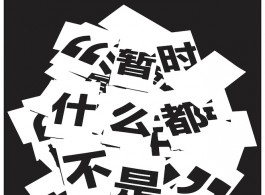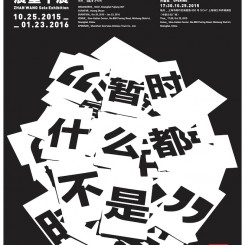Organizers: OCAT, Shanghai Pujiang OCT
Sponsor: Shenzhen Overseas Chinese Town Co., Ltd.
Curator: Huang Zhuan
Duration: Oct 25, 2015 – Jan 23, 2016
Venue: Sino-Italian Center, No.800 Puxing Road, Minhang District, Shanghai, China
Press Conference
Time: 16:00, Oct 25, 2015
Venue: Conference Room in Building C, Sino-Italian Center, No.800 Puxing Road, Minhang District, Shanghai, China
Opening
Time: 17:30, Oct 25, 2015
Venue: Sino-Italian Center, No.800 Puxing Road, Minhang District, Shanghai, China
This installment of the Shanghai Pujiang OCT Ten Year Public Art Project, China’s longest and most influential public art project, will feature a large scale solo exhibition and 17.5 Degrees of Deviation. The artist chosen for this year’s solo exhibition segment is Zhan Wang, who will present two entirely new art series for the public art project, Metamorph and Terrain. The 2015 Shanghai Pujiang OCT Ten Year Public Art Project will also install the 9th marker in the 17.5°Deviation installation, to be held simultaneously with the opening of Zhan Wang’s Nothing for the Time Being.
As a leading figure in experimental Chinese contemporary sculpture, Zhan Wang is known for using simple material forms to create complex issues. His artistic experiments are like an intellectual game that constantly seeks balance between the perceived world and the material world. The true beginnings of Zhan Wang’s art can be traced back to his imprinting of the contours of “Taihu stones,” but over the span of twenty years, this symbolic motif came to seem like an intellectual labyrinth with no discernable end, leading Zhan Wang’s creations to touch on a growing range of mediums and materials, and to span cultural and natural history. In the imprinting carried out for the artworks Artificial Rocks, he discovered a conceptual question contained within sculpture, which is how sculpture pieces the world together. In his work, he uncovered many possibilities for this question, yet he carefully contained this pursuit within the boundaries of sculpture. “Nothing for the time being” is a phrase Zhan Wang used in his artist statement, and it aptly summarizes the uncertain properties of his artistic experiments.
The two sets of artworks Zhan Wang is providing for the 2015 Shanghai Pujiang OCT Ten-year Public Art Project are an entirely new experiment in this question of “piecing the world together.” Terrain uses the same industrial materials as Artificial Rocks, but has removed the carrier of the “Taihu stone,” instead deriving its contours from a public space, giving this experiment the properties of a public exchange. In Metamorph, the artist uses soft material to rediscover the artist’s form as it appears in Morph through the lens of plasticism, bringing these disintegrated body parts together to form a new world of shapes, the formative principles of which are not determined by naturalist objective imitation, nor by Expressionist subjective reconstruction, much less the simulated reproduction of Pop. Its formative process is a certain form of relational visual projection, the reformulation of mirror image forms, which Zhan Wang calls a “re-dismantlement” of the shapes in Morph. The result is a world that exists in a primordial state between abstraction and concreteness. From the imprinting of shapes, to the “morphing” of shapes and on to “metamorphing,” Zhan Wang’s creations are like a contemporary topographic study of the ancient question of how art “imitates” the world, one carried out in the medium of sculpture that explores how tangible forms, under the conditions of continued change, maintain unchanging formative character. His art avoids the dimensions of political and social criticism so commonly seen in contemporary art, and strives to distance itself from the overly spectaclistic and anti-history forms of postmodern art. It is this work within the logic of construction that give his art an uncertain experimental nature.
About Artist
Zhan Wang, born December 14, 1962, in Beijing, enjoyed painting since he was a child. In his youth, his maternal grandfather exposed him to Chinese landscape painting. From the age of fifteen to nineteen (1978-1981), he studied at the Beijing Academy of Applied Art (now the Beijing Academy of Art and Design) in the Special Craft Department, where he studied traditional crafts and various popular art forms. At the age of 21 (1988), he was accepted into the Central Academy of Fine Art Sculpture Department, where he received orthodox (Soviet) training in sculpture. In his third year, he entered the studio of Situ Zhaoguang, where he studied Chinese and Western sculpture. Upon graduation, he remained at the school as an instructor, where he still teaches to this day.
Zhan Wang is an important representative figure of Chinese contemporary art in the international art scene, as well as a leading figure of Chinese sculpture. His works touch on sculpture, installation, photography and multimedia. The stainless steel Artificial Rocks series, begun in 1995, gained him international acclaim and has been collected around the world. These rocks, based entirely on rocks from nature, are made through a painstaking handcrafted process for which he received a Chinese patent in 2002. Zhan Wang’s artworks were the first works of Chinese contemporary sculpture to be collected by the Museum of Metropolitan Art in New York and the British Museum in London, as well as the Deyang Museum in San Francisco, the Museum of Fine Arts, Boston, and the Museum of Contemporary Art, Los Angeles. They have been featured in many important international contemporary exhibitions, biennials and triennials including Venice, Shanghai, Singapore and Guangzhou.
Possessing a strong experimental spirit, Zhan Wang draws from Eastern and Western tradition as well as developments in modern and contemporary art, while maintaining independent and sustained creative methods all his own. Much of his work is focused on reshaping nature, with such works as Artificial Rocks bringing China’s literati culture into the international contemporary field of vision. His rock philosophy is embodied in the analysis of the truth and falsehood of reality, as he uses Western techniques and modern materials to deconstruct Eastern tradition. His stainless steel rock landscapes have found a channel between the traditional and contemporary through the fusion and transference of culture. His refined iconography has decoded certain core elements of our time. His most recent works have focused on the exploration of conceptual form.


